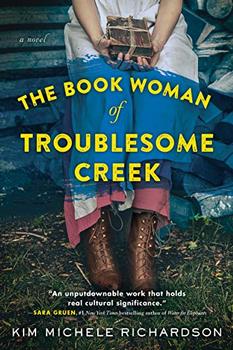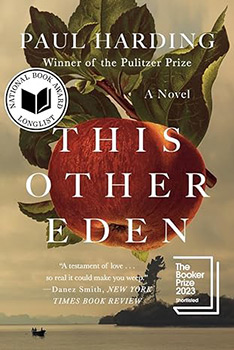Summary | Excerpt | Reading Guide | Discuss | Reviews | Beyond the book | Read-Alikes | Genres & Themes | Author Bio

A Novel
by Kim Michele RichardsonA loyal animal companion, treks through gorgeous but forbidding wilderness, glimpses of larger historical events through personal and regional experiences: These components appear in many works of fiction intended to entertain and educate young people. They also emerge in Kim Michele Richardson's The Book Woman of Troublesome Creek, a novel set in the 1930s that is perfect for adults who grew up with the adventure and whimsy of books by Lucy Maud Montgomery and Laura Ingalls Wilder.
Cussy Mary Carter, known alternately as Bluet and Book Woman, is a blue-skinned Kentuckian of French descent—based on the Blue Fugates of Kentucky, a genetic ancestral line of people suffering from a rare blood disorder called methemoglobinemia that caused their skin to appear bluish-purple. She spends her days working as a Pack Horse librarian, toting books to the rural people of Troublesome Creek and surrounding areas amidst extreme poverty. Her job and way of life are threatened when her father, a struggling coal miner, marries her off to an abusive older man. However, a stroke of poetic justice soon enables Cussy to return to work with her newly adopted mule Junia, a fierce beast who will protect her mistress at all costs.
Despite the harsh and dangerous nature of Cussy's life and work, Richardson manages to infuse The Book Woman of Troublesome Creek with a sense of wonder. The characters along Cussy's route, each with their distinct dispositions and back stories, add to the novel's playful, picaresque feel. We journey with the protagonist as she visits children in a schoolhouse, an old woman with poor eyesight who depends on the Pack Horse librarian for regular Bible-reading sessions, a man sick from a gunshot wound and eligible bachelor Jackson Lovett—who we can guess from his first encounter with Cussy (or from his name alone) may be destined for a romantic future with our Book Woman.
As a Blue, Cussy experiences discrimination, which is informed by the anti-black racism of the time. The white townspeople and sheriff expect her to abide by the same segregation regulations as Black people in Troublesome, and many are afraid to touch her, fearing a contagion or some unknown consequence. She finds herself in a personal and moral dilemma when the local doctor assures her that he can "cure" her blueness.
Cussy's struggle with her appearance is believable, but the book never fully acknowledges the complexity of her relationship with historical racism. As a person of European ancestry rejected by a white community, she shares experiences with people of other races, but in a complicated and incomplete way. She privately sees herself as objectively worse off than her friend Queenie, a Black woman and fellow Pack Horse librarian, despite there being no evidence that the two have ever compared thoughts on the matter. It makes sense that Cussy would feel this way, having grown up as the only one of her kind in an isolated location and therefore having a limited perspective on race relations. It also seems possible that Queenie, who appears to keep a polite distance from Cussy while also showing genuine affection for her, might view Cussy as a fellow oppressed minority and yet, simultaneously, as a white woman. It would be interesting to explore this angle—however, Cussy's (understandably) simplistic thinking is never upset by a moment of conflict with Queenie or any other character. Even one short, strained exchange might have made for a less reductive presentation of systemic racism, and a more nuanced take on Cussy's feelings about her own identity.
At times, Richardson's novel also feels a bit shallow in the romance department, but this isn't necessarily a problem. Cussy isn't a particularly romantic individual after all, and frankly, she doesn't have time to undergo a fancy, languorous courtship. It's actually amusing to see her lingering interest in Jackson relegated to the background for much of the book as she crashes through the woods with bigger concerns on her mind, bringing deliveries to her patrons; spontaneously tending to the sick and hungry; and negotiating encounters with dangerous men, death-defying mountain paths and, at one point, a rattlesnake.
The Book Woman of Troublesome Creek puts its own offbeat spin not just on classic romance but also crime, action and adventure, suspense and, of course, historical fiction—all with a flawed but sympathetic lead at its center. In addition to spotlighting a fascinating phenomenon in book history, it is itself a book lover's book, a celebration of stories and genres, an exercise in reading nostalgia. It may just take you back to hushed afternoons in the school library, nights hiding with a flashlight and paperback under the covers, those magical days of discovering reading for pleasure.
![]() This review was originally published in The BookBrowse Review in October 2019, and has been updated for the
December 2019 edition.
Click here to go to this issue.
This review was originally published in The BookBrowse Review in October 2019, and has been updated for the
December 2019 edition.
Click here to go to this issue.

If you liked The Book Woman of Troublesome Creek, try these:

by Evan Friss
Published 2024
An affectionate and engaging history of the American bookstore and its central place in American cultural life, from department stores to indies, from highbrow dealers trading in first editions to sidewalk vendors, and from chains to special-interest community destinations

by Paul Harding
Published 2023
From the Pulitzer Prize–winning author of Tinkers, a novel inspired by the true story of Malaga Island, an isolated island off the coast of Maine that became one of the first racially integrated towns in the Northeast.
Your guide toexceptional books
BookBrowse seeks out and recommends the best in contemporary fiction and nonfiction—books that not only engage and entertain but also deepen our understanding of ourselves and the world around us.